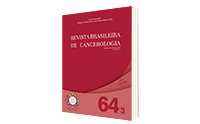Nutritional Profile of Children with Brain Tumor with Diencephalic Syndrome or Russell Syndrome receiving Enteral Diet
DOI:
https://doi.org/10.32635/2176-9745.RBC.2018v64n3.36Keywords:
Silver-Russell Syndrome, Brain Neoplasms, Enteral Nutrition, Nutrition Therapy, ChildAbstract
Introduction: Diencephalic syndrome is a rare disorder of infancy characterized by profound emaciation with failure to thrive. The majority of cases of the syndrome are due to low grade gliomas of the anterior hypothalamus or optic nerve. Objective: To report the nutritional status and efficacy of nutritional support in patients with brain tumors that developed the Russell’s Syndrome. Method: Seven patients were retrospectively evaluated by means of z-score of the weight for age (W/A), weight for height (W/H) and Height for age (H/A) nutritional status index, for protein-energy malnutrition diagnosis. They were evaluated by means of triceps skinfold thickness (TSFT), arm circumferences (AC) and muscle arm circumferences (MAC) and received enteral nutrition, by nasoenteral tube or gastrostomy at cancer diagnostic. Results: The ages ranged from 2 months to 13 years, five children were males. Mean of the nutritional support was 7 months (1.1-18.5 months) after diagnostic, without statistical differences in z-scores evolution, but there are increase in averages of the W/A (-4,42 to -3,50) and W/H (-3,06 to -1,99), and body composition indicators (TSFT): 2.85 to 4.88, AC: 9.81 to 11.84 and MAC: 8.91 to 10.31). There was decreased in average of H/A, evidencing the growth arrest of these children. Conclusion: Enteral feeding has been shown to guarantee nutritional supply and to partially recover nutritional indicators of acute malnutrition; especially body fat, rather than lean mass. However, the growth deficit was not corrected, being aggravated in most cases. Nutritional support should be implanted during oncological treatment, ensuring its maintenance.Downloads
Download data is not yet available.
Downloads
Published
2018-09-28
How to Cite
1.
Garófolo A, Silva NS, Cavalheiro S. Nutritional Profile of Children with Brain Tumor with Diencephalic Syndrome or Russell Syndrome receiving Enteral Diet. Rev. Bras. Cancerol. [Internet]. 2018 Sep. 28 [cited 2025 Dec. 15];64(3):357-63. Available from: https://rbc.inca.gov.br/index.php/revista/article/view/36
Issue
Section
ORIGINAL ARTICLE









